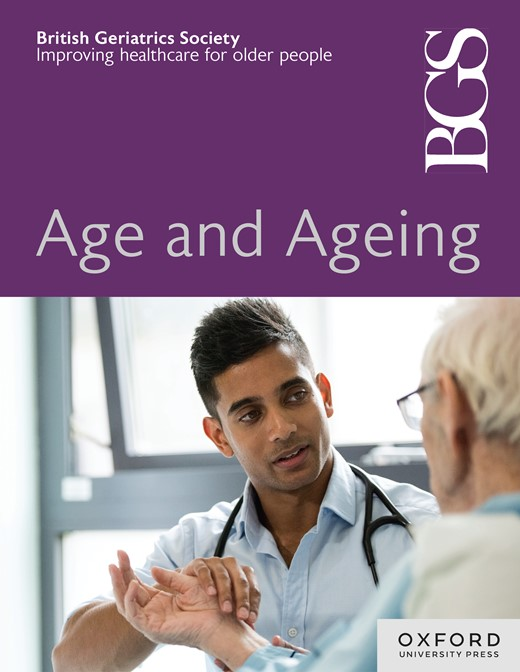3221 Collaborative care: enhancing frailty management and patient safety through nurse-pharmacist partnerships
IF 6
2区 医学
Q1 GERIATRICS & GERONTOLOGY
引用次数: 0
Abstract
Introduction Frailty presents significant challenges to healthcare systems, particularly in Thurrock, Essex, where 14% of residents are aged 65 or older. This demographic shift, combined with socioeconomic factors, underscores the need for patient-centred, clinically effective, and tailored healthcare services that prioritise patient safety. Aim To improve frailty management for elderly patients in Thurrock by integrating pharmacist support within a nurse-led service, focusing on medication management, reducing workload pressures, providing holistic, patient-centred care, and ensuring patient safety to enhance outcomes and reduce hospital admissions. Method A 12-week pilot involved patients aged 65+ undergoing joint reviews with a frailty nurse and pharmacist. Participants had a Rockwood Frailty Score of 5–7 and at least one long-term condition. Reviews included evaluations of medication, functional and falls risks, nutritional status, fracture risk, and blood tests. The management phase focused on deprescribing, dose adjustments, and addressing health metrics such as postural hypotension, bone protection, and falls risk. Regular follow-ups ensured coordinated care with a focus on patient-centred outcomes and patient safety. Results From April 4 to June 28, 2024, 37 patients (mean age: 84) participated. Comprehensive assessments led to 155 interventions (averaging 4.07 per patient). Medication management improved significantly, with 88 drugs deprescribed, including 55 Falls Risk Increasing Drgs (FRIDs), resulting in a 14.39% reduction in FRIDs and a 23.03% reduction in polypharmacy. These interventions led to £6252.18 in annual drug savings and a 974.09 kg reduction in CO2 emissions. Key outcomes included 57 health and social interventions. Financial analysis suggested savings of £63,450 from preventable hospital admissions, with a return on investment (ROI) of 1655.4%. Conclusion The pilot demonstrated the clinical effectiveness of pharmacist-nurse collaboration in improving medication management, chronic condition control, reducing falls risk, and preventing hospital admissions. It emphasises the importance of patient-centred care, safety, and skill mixing to enhance clinical outcomes.3221协同护理:通过护士-药剂师合作加强虚弱管理和患者安全
身体虚弱对医疗保健系统提出了重大挑战,特别是在瑟罗克,埃塞克斯,其中14%的居民年龄在65岁或以上。这种人口结构的变化,再加上社会经济因素,强调了对以患者为中心、临床有效和量身定制的医疗保健服务的需求,这些服务应优先考虑患者的安全。目的通过在护士主导的服务中整合药剂师支持,专注于药物管理,减少工作量压力,提供全面的,以患者为中心的护理,并确保患者安全,从而改善Thurrock老年患者的虚弱管理,以提高结果并减少住院人数。方法对65岁以上的患者进行为期12周的试验,由一名衰弱护士和一名药剂师进行联合复查。参与者的Rockwood虚弱评分为5-7,并且至少有一项长期疾病。回顾包括药物评估、功能和跌倒风险、营养状况、骨折风险和血液检查。管理阶段侧重于处方、剂量调整和处理健康指标,如体位性低血压、骨骼保护和跌倒风险。定期随访确保协调护理,重点关注以患者为中心的结果和患者安全。结果2024年4月4日至6月28日,共纳入37例患者,平均年龄84岁。综合评估导致155项干预(平均每位患者4.07项)。用药管理得到显著改善,共开了88种药物,其中55种为降低风险的药物(frid),减少了14.39%的frid,减少了23.03%的多重用药。这些干预措施导致每年节省6252.18英镑的药物和减少974.09公斤的二氧化碳排放。主要成果包括57项保健和社会干预措施。财务分析表明,可预防的住院治疗可节省63,450英镑,投资回报率(ROI)为1655.4%。结论药师护协作在改善用药管理、慢性病控制、降低跌倒风险、预防住院等方面具有临床效果。它强调以患者为中心的护理、安全和技能混合的重要性,以提高临床结果。
本文章由计算机程序翻译,如有差异,请以英文原文为准。
求助全文
约1分钟内获得全文
求助全文
来源期刊

Age and ageing
医学-老年医学
CiteScore
9.20
自引率
6.00%
发文量
796
审稿时长
4-8 weeks
期刊介绍:
Age and Ageing is an international journal publishing refereed original articles and commissioned reviews on geriatric medicine and gerontology. Its range includes research on ageing and clinical, epidemiological, and psychological aspects of later life.
 求助内容:
求助内容: 应助结果提醒方式:
应助结果提醒方式:


